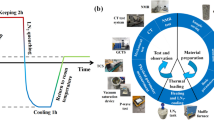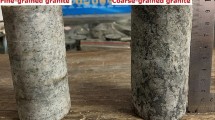Abstract
Deep hot dry rock (HDR) masses undergo complex geological structural changes, forming fractured-subsequently filled granite. Owing to the different diagenetic and geological environments, the mineral compositions and microstructures of deep HDR masses are significantly different from those of shallow granites. The static parameters and mechanical properties of granite parent rock, hydrothermal fluid backfill, and fractured-subsequently filled granite under high temperature (500 ℃) and high pressure were studied to examine the effect of hydrothermal fluid backfill on the characteristics of deep, natural granite, and thus guide HDR geothermal exploitation. The results showed that the fractured-subsequently filled granite near the cementation interface had the largest longitudinal wave velocity and lowest porosity. A two-stage change in the elastic modulus of the fractured-subsequently filled granite was observed with increasing temperature, and the hydrothermal fluid backfill exhibited the minimum elastic modulus. The cementation interface develops into a weak-plane structure at high temperatures; as a result, the fractured-subsequently-filled granite near the cementation interface has the minimum compressive strength. In addition, the main shear fracture plane extended along the cementation interface when the angle between the cementation interface and the horizontal plane was 65°–69°. The different mineral compositions and microstructures of the granite parent rock and hydrothermal fluid backfill, as well as the healing effect near the cementation interface, result in changes in the physical and mechanical properties of the granite near the cementation interface.
Highlights
-
Granite near cementation interface has the largest longitudinal wave velocity, the lowest porosity and the minimum compressive strength.
-
A two-stage change of fractured-subsequently filled granite elastic modulus with increasing temperature was observed.
-
Dissolution pore structure leads to the lowest elastic modulus of hydrothermal fluid backfill within 500 ℃.
-
The shear fracture plane extends along cementation interface when the angle between cementation interface and horizontal plane is 65°–69°.












Similar content being viewed by others
Data availability
All data generated or analyzed during this study are included in this published article and are available from the corresponding author on reasonable request.
References
Brace WF (1961) Dependence of fracture strength of rocks on grain size. In: The 4th US Symposium on Rock Mechanics (USRMS)
Brown JM, Abramson EH (2016) Elasticity of calcium and calcium-sodium amphiboles. Phys Earth Planet Inter 261:161–171
Cai MF (2002) Rock mechanics and engineering. Science Press, Beijing, pp 12–13
Chen WM, Ying TZ, Chen YZ et al (1999) Thermal expansion of fluosilicate glass-ceramics. J Inorg Mater 14(2):271–274
Chen YL, Wang SR, Ni J (2017) An experimental study of the mechanical properties of granite after high temperature exposure based on mineral characteristics. Eng Geol 220:234–242
Du SJ, Ma M, Chen HH (2003) Testing study on longitudinal wave characteristics of granite after high temperature. Chin J Rock Mechan Eng 22(11):1803–1806 (in Chinese)
Du K, Yang C, Su R, Tao M, Wang S (2020) Failure properties of cubic granite, marble, and sandstone specimens under true triaxial stress. Int J Rock Mech Mining Sci 130:104309
Du K, Sun Y, Zhou J, Wang SF, Tao M, Yang C, Khandelwal M (2021) Low amplitude fatigue performance of sandstone, marble, and granite under high static stress. Geomech Geophys Geo-Energy Geo-Resour 7(3):1–21
Du K, Sun Y, Zhou J et al (2022) Mineral composition and grain size effects on the fracture and acoustic emission (AE) characteristics of rocks under compressive and tensile stress. Rock Mech Rock Eng 36(4):255–270
Engineering ToolBox (2003) Coefficients of linear thermal expansion. https://www.engineeringtoolbox.com/linear-expansion-coefficients-d_95.html. Accessed 16 June 2020
Feng ZC, Zhao YS (2008) Control effect of fissure scale on deformation and failure of rock mass. Chin J Rock Mechan Eng 27(1):78–83 (in Chinese)
Feng ZJ, Zhao YS, Zhang Y et al (2018) Real-time permeability evolution of thermally cracked granite at triaxial stresses. Appl Therm Eng 133:194–200
Gunsallus KL, Kulhawy FH (1984) A comparative evaluation of rockstrength measures. Int J Rock Mech Min Sci 21:233–248
He JM, Afolagboye LO, Zheng B et al (2022) Effect of strain rate on anisotropic mechanical behavior of the shale under uniaxial compression conditions. Rock Mech Rock Eng 55:5297–5305
Heard HC (1980) Thermal expansion and inferred permeability of climax quartz monazite to 300 ℃ and 27.6MPa. Int J Rock Mech Min Sci Geomech Abstr 17:289–296
Hu J, Sun Q, Pan X (2018) Variation of mechanical properties of granite after high-temperature treatment. Arab J Geosci 11(2):43
Huang YH, Yang SQ, Tian WL et al (2017) Physical and mechanical behavior of granite containing pre-existing holes after high temperature treatment. Arch Civil Mech Eng 17(4):912–925
Huang YH, Yang SQ, Bu YS (2020) Effect of thermal shock on the strength and fracture behavior of pre-flawed granite specimens under uniaxial compression. Theor Appl Fract Mech 106:102474
Irfan TY (1996) Mineralogy, fabric properties and classification of weathered granites in Hong Kong. QJEGH 29:5–35
Jaeger JC, Cook NGW, Zimmerman RW (2007) Fundamentals of rock mechanics. Blackwell Publishing
Ji SC, Shao TB, Michibayashi K et al (2013) A new calibration of seismic velocities, anisotropy, fabrics, and elastic moduli of amphibole-rich rocks. J Geophys Res Solid Earth 118:4699–4728
Jiang GH, Zuo JP, Li LY et al (2018) The evolution of cracks in Maluanshan granite subjected to different temperature processing. Rock Mech Rock Eng 51:1683–1695
Jin FL, Park SJ (2008) Impact-strength improvement of epoxy resins reinforced with a biodegradable polymer. Mater Sci Eng A 478:402–405
Kumari WG, Ranjith PG, Perera MSA et al (2017) Mechanical behaviour of Australian Strathbogie granite under in-situ stress and temperature conditions: an application to geothermal energy extraction. Geothermics 65:44–59
Lindqvist JE, Åkesson U, Malaga K (2007) Microstructure and functional properties of rock materials. Mater Charact 58(11–12):1183–1188
Liu S, Xu JY (2015) An experimental study on the physico-mechanical properties of two post-high-temperature rocks. Eng Geol 185:63–70
Liu QS, Xu XC, Tsutomo Y, Akio C (2001) Testing study on mechanical properties of the three gorges granite concerning temperature and time. Chin J Rock Mech Eng 20:715–719 (in Chinese)
Lu SM (2017) A global review of enhanced geothermal system (EGS). Renew Sustain Energy Rev 81:2902–2921
Meier T, Rybacki E, Backers T, Dresen G (2015) Influence of bedding angle on borehole stability: a laboratory investigation of transverse isotropic oil shale. Rock Mech Rock Eng 48:1535–1546
Ministry of Land and Resources PRC (2015) Technical specification for rock and ore identification—part 4: identification of thin sections of rock: DZ/T 02754–2015. Ministry of Land and Resources
Norio T, Tsutomu Y, George Z (2008) The Hijiori Hot Dry Rock test site, Japan Evaluation and optimization of heat extraction from a two-layered reservoir. Geothermics 37:19–52
Pikryl R (2001) Some microstructural aspects of strength variation in rocks. Int J Rock Mech Min Sci 38:671–682
Přikryl R, Lokajíček T, Li C, Rudajev V (2003) Acoustic emission characteristics and failure of uniaxially stressed granitic rocks: the effect of rock fabric. Rock Mech Rock Eng 36(4):255–270
Richard M, Rieke HH, Kim YC (1970) Tensile strength related to mineralogy and texture of some granitic rocks. Eng Geol 4:155–160
Shi Y, Song X, Shen Z et al (2018) Numerical investigation on heat extraction performance of a CO2 enhanced geothermal system with multilateral wells. Energy 163:38–51
Takarli M, Prince W, Siddique R (2008) Damage in granite under heating/cooling cycles and water freeze–thaw condition. Int J Rock Mech Min 45(7):1164–1175
Tuğrul A, Zarif IH (1999) Correlation of mineralogical and textural characteristics with engineering properties of selected granitic rocks from Turkey. Eng Geol 51(4):303–317
Ulusay R, Hudson JA (2007) The complete ISRM suggested methods for rock characterization, testing and monitoring. Iskitler, Ankara
Wan ZJ, Zhao YS, Dong FK et al (2008) Experimental study on physical properties of granite under high temperature and triaxial stress. Chin J Rock Mech Eng 27(001):72–77 (in Chinese)
Wang HF, Bonner BP, Carlson SR et al (1989) Thermal stress cracking in granite. J Geophys Res 94(B2):1745–1758
Whitney DL, Broz M, Cook RF (2007) Hardness, toughness, and modulus of some common metamorphic minerals. Am Miner 92(2–3):281–288
Yang SQ, Ranjith PG, Jing HW, Tian WL, Ju Y (2017a) An experimental investigation on thermal damage and failure mechanical behavior of granite after exposure to different high temperature treatments. Geothermics 65:180–197
Yang SQ, Xu P, Li YB, Huang YH (2017b) Experimental investigation on triaxial mechanical and permeability behavior of sandstone after exposure to different high temperature treatments. Geothermics 69:93–109
Yang Z, Yang SQ, Chen M (2020) Peridynamic simulation on fracture mechanical behavior of granite containing a single fissure after thermal cycling treatment. Comput Geotech 120:103414
Yin WT, Zhao YS, Feng ZJ (2019) Experimental research on the rupture characteristics of fractures subsequently filled by magma and hydrothermal fluid in hot dry rock. Renew Energ 139:71–79
Yin WT, Feng ZJ, Zhao YS (2021) Effect of grain size on the mechanical behaviour of granite under high temperature and triaxial stresses. Rock Mech Rock Eng 54(2):745–758
Yong C, Wang C (1980) Thermally induced acoustic emission in westerly granite. Geophys Res Lett 7(12):1089–1092
Yu CQ, Song XJ, Li JJ et al (2013) Impact of feldspar dissolution on reservoir physical properties: a case from Dongying Sag, the Bohai Bay Basin. Oil Gas Geol 34(6):765–770 (in Chinese)
Zhang SR, Wang XH, Wang C (2017) Effects of pore structure and its development degree on dissolution rock mechanical characteristics. J Tianjin Univ (science and Technology) 50(10):1018–1028 (in Chinese)
Zhang YJ, Ma YQ, Hu ZJ et al (2019) An experimental investigation into the characteristics of hydraulic fracturing and fracture permeability after hydraulic fracturing in granite. Renew Energy 140:615–624
Zhao YS, Meng QR, Kang TH et al (2008) Micro-CT experimental technology and meso-investigation on thermal fracturing characteristics of granite. Chin J Rock Mech Eng 27:28–34 (in Chinese)
Zhao YS, Wan ZJ, Feng ZJ et al (2012) Triaxial compression system for rock testing under high temperature and high pressure. Int J Rock Mech Min Sci 52:132–138
Zhao YS, Feng ZJ, Zhao Y et al (2017a) Experimental investigation on thermal cracking, permeability under HTHP and application for geothermal mining of HDR. Energy 132:305–314
Zhao YS, Wan ZJ, Feng ZC et al (2017b) Evolution of mechanical properties of granite at high temperature and high pressure. Geomech Geophys Geo-Energ Geo-Resour 3:199–210
Zheng KY, Pan XP (2009) Current situation and prospect of geothermal power generation in China. SINO-Glob Energy 14(02):45–48
Zhou H, Liu H, Hu D et al (2016) Anisotropies in mechanical behavior, thermal expansion and P-wave velocity of sandstone with bedding planes. Rock Mech Rock Eng 49(11):4497–4504
Acknowledgements
This work was supported by the National Natural Science Foundation of China (Grant Nos. 52122405), the project of the major special plan of science and technology of Shanxi Province (Grant Nos. 202101060301024), and the Basic Research Program of Shanxi Province (Free Exploration) (Grant Nos. 202103021223071).
Author information
Authors and Affiliations
Corresponding author
Ethics declarations
Conflict of Interest
The authors declare that they have no conflict of interest.
Additional information
Publisher's Note
Springer Nature remains neutral with regard to jurisdictional claims in published maps and institutional affiliations.
Rights and permissions
Springer Nature or its licensor (e.g. a society or other partner) holds exclusive rights to this article under a publishing agreement with the author(s) or other rightsholder(s); author self-archiving of the accepted manuscript version of this article is solely governed by the terms of such publishing agreement and applicable law.
About this article
Cite this article
Yin, W., Zhao, Y. & Feng, Z. Effect of Hydrothermal Fluid Backfill on the Mechanical Behavior of Deep Granite Under High-Temperature and High-Pressure Conditions. Rock Mech Rock Eng 56, 4923–4937 (2023). https://doi.org/10.1007/s00603-023-03310-6
Received:
Accepted:
Published:
Issue Date:
DOI: https://doi.org/10.1007/s00603-023-03310-6




